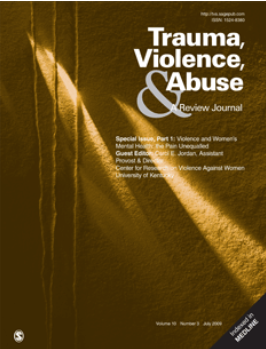性别暴力中煤气灯的定义:一种混合方法的系统回顾
IF 5.4
1区 社会学
Q1 CRIMINOLOGY & PENOLOGY
引用次数: 0
摘要
在公共和学术话语中,煤气灯越来越受到关注,特别是在心理虐待、权力不平衡和性别暴力(GBV)方面。然而,煤气灯一词的定义往往不一致,并与更广泛的操纵形式混为一谈。它也主要在亲密伴侣暴力(IPV)的背景下进行审查,忽视了其他形式的性别暴力。本研究提出了一个系统的综述,综合跨学科的学术文献,以创建一个全面的煤气灯框架。该框架包括煤气灯肇事者使用的具体策略,幸存者经历的社会心理后果,以及系统性不平等和社会权力动态的作用。通过对多个数据库的搜索,确定了96条讨论煤气灯与GBV相关的记录。专题分析揭示了理解煤气灯的两部分框架:(a)煤气灯策略,分为认知和知觉操纵、情感和心理虐待、权力动态和控制以及其他操纵形式;(b)幸存者结果,包括感知和记忆中断、情绪困扰、社会孤立和抵抗策略。研究结果表明,煤气灯不仅仅是一种人际行为;它在社会结构中持续存在,犯罪者利用身份因素和边缘化形式剥削幸存者。总的来说,这篇综述提出了煤气灯的一个全面的定义,说明了它的认识论性质及其与系统压迫的交集。建议未来的研究应超越IPV对GBV背景下煤气灯的研究,而实践和政策努力应寻求加强对幸存者的认可和支持。本文章由计算机程序翻译,如有差异,请以英文原文为准。
Defining Gaslighting in Gender-Based Violence: A Mixed-Methods Systematic Review
In both public and academic discourse, gaslighting has gained increased attention, especially regarding psychological abuse, power imbalance, and gender-based violence (GBV). However, the term gaslighting is often inconsistently defined and conflated with broader forms of manipulation. It is also largely examined in the context of intimate partner violence (IPV), which ignores its occurrence in other forms of GBV. The present study presents a systematic review that synthesizes interdisciplinary academic literature to create a comprehensive framework of gaslighting. This framework includes the specific tactics that are used by perpetrators of gaslighting, the social–psychological outcomes experienced by survivors, and the role of systemic inequalities and social power dynamics. A search across multiple databases identified 96 records that discussed gaslighting in relation to GBV. Thematic analysis revealed a two-part framework for understanding gaslighting: (a) gaslighting tactics, which were categorized into cognitive and perceptual manipulation, emotional and psychological abuse, power dynamics and control, and additional forms of manipulation and (b) survivor outcomes, including disruptions to perception and memory, emotional distress, social isolation, and resistance strategies. The findings show that gaslighting is more than just an interpersonal act; it is sustained within social structures, where perpetrators use identity factors and forms of marginalization to exploit survivors. Overall, this review presents a comprehensive definition of gaslighting that illustrates its epistemic nature and its intersection with systemic oppression. It is suggested that future research studies gaslighting in GBV contexts beyond IPV, while practice and policy efforts should seek to enhance recognition and support for survivors.
求助全文
通过发布文献求助,成功后即可免费获取论文全文。
去求助
来源期刊

Trauma Violence & Abuse
Multiple-
CiteScore
13.60
自引率
7.80%
发文量
131
期刊介绍:
Trauma, Violence, & Abuse is devoted to organizing, synthesizing, and expanding knowledge on all force of trauma, abuse, and violence. This peer-reviewed journal is practitioner oriented and will publish only reviews of research, conceptual or theoretical articles, and law review articles. Trauma, Violence, & Abuse is dedicated to professionals and advanced students in clinical training who work with any form of trauma, abuse, and violence. It is intended to compile knowledge that clearly affects practice, policy, and research.
 求助内容:
求助内容: 应助结果提醒方式:
应助结果提醒方式:


